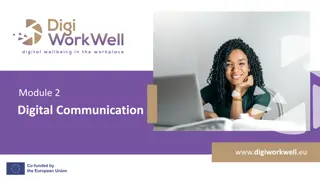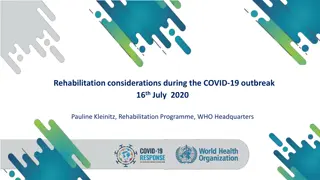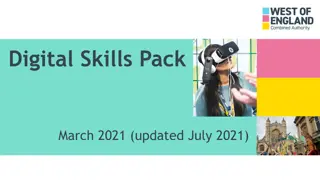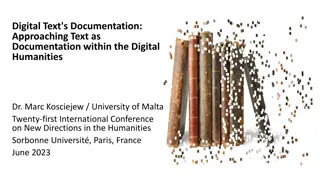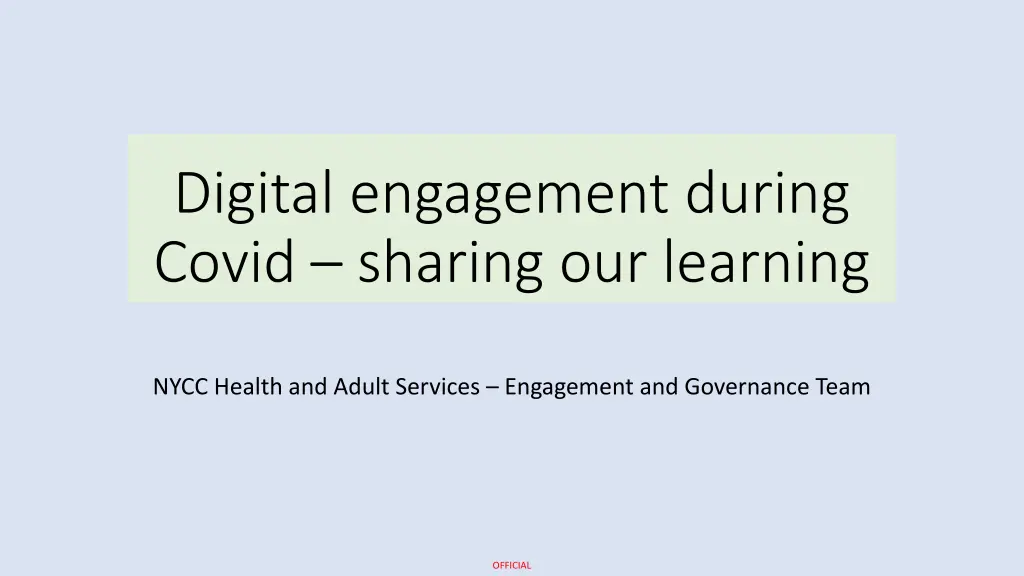
Enhancing Engagement: Digital Strategies During Covid-19
"Learn about the digital engagement strategies implemented by NYCC Health and Adult Services during the Covid-19 pandemic. Find out how they successfully transitioned from in-person activities to online platforms, supporting accessibility and learning. Explore the benefits, challenges, and inclusive practices for effective online meetings and participation."
Download Presentation

Please find below an Image/Link to download the presentation.
The content on the website is provided AS IS for your information and personal use only. It may not be sold, licensed, or shared on other websites without obtaining consent from the author. If you encounter any issues during the download, it is possible that the publisher has removed the file from their server.
You are allowed to download the files provided on this website for personal or commercial use, subject to the condition that they are used lawfully. All files are the property of their respective owners.
The content on the website is provided AS IS for your information and personal use only. It may not be sold, licensed, or shared on other websites without obtaining consent from the author.
E N D
Presentation Transcript
Digital engagement during Covid sharing our learning NYCC Health and Adult Services Engagement and Governance Team OFFICIAL
The situation Much of our engagement activity was carried out in person meeting people at community forums, events and so on North Yorkshire Disability Forum and local forums North Yorkshire Learning Disability Partnership Board and local groups Older people s forums Going where people already gather Covid-19 had to rapidly pivot to online and other distance methods Not something that we, or the people we regularly work with, had done much of! OFFICIAL
What did we do? Sourced an accessible online platform (not perfect but better than Skype) Supported people to access it via easy read guidelines, individual coaching, trial meetings to get used to it Quizzes and other fun stuff to help self-advocates feel comfortable and confident Changed the way we run meetings Helped some people to access digital kit We all learned together lots of feedback, adjusting and finding solutions OFFICIAL
Capturing the learning We didn t want to lose our learning so we pulled it together into a report: Digital Inclusion and Accessibility: Learning from Participation and Engagement Activity During Covid-19 Accessibility four main areas to consider: 1. Access to digital kit practical how to and affordability 2. Access to data practical how to and affordability 3. Support to learn how to use kit, software, apps etc, and online security 4. Accessibility of online meetings/events how they are planned, communicated and facilitated Benefits of online working and some constraints It s not an option for some people so how do we include them? OFFICIAL
Top tips for effective online meetings Top tips for effective online meetings Do your research. Find out what participants needs are and, wherever possible, select the platform that best meets them. If you need partners from other organisations to join, check if they have any restrictions on which platforms they are able to access. Number of participants. If you have too many people present it will be difficult to manage the meeting so that everyone can contribute. The ideal number will depend on the type of meeting but, generally, we would recommend a maximum of 15-20 people for working meetings with active discussion. Meeting length. People can tire quicker than in face-to-face meetings so do not make meetings too long. We would recommend an hour and half, or two hours with a break, as a maximum. Agenda. Do not be overambitious about how much you can fit in. It can take longer to get through each issue in online meetings, particularly if there are technological difficulties. Offer a 1-1 practice session before the meeting this allows people to get used to the platform and enables you to troubleshoot any problems beforehand. This can require a significant amount of time so ensure you plan accordingly and be prepared to offer follow-up sessions. OFFICIAL
Ensure that participants are familiar with different features and layouts ahead of the meeting. This will help people configure the experience to suit them and participate fully. Find out what the platform looks like on different devices. The screen is often laid out differently on smartphones, tablets and laptops. Being familiar with the various layouts will help you better support people remotely. Provide people with accessible information let people know how to take part in the meeting, how to use the platform and different functions like the mute button and chat box, and what to do if they have problems. Review your meeting rules to make sure they allow everyone to have their say. Remind people to use the mute button when they are not talking. This is especially important to improve the sound quality for people with hearing loss. Encourage people to participate by using the chat box as well as by speaking. Make sure that someone is keeping an eye on the chat box and can feed this into the meeting as well as the minutes. OFFICIAL
Consider safeguarding. Set ground rules about how to use the messaging function and ensure that the meeting organiser always checks the chat log after the meeting. Open the meeting room 10-15 minutes before the meeting starts. Encourage people to join early so they can resolve issues and get settled. Make sure people have a contact number for the meeting organiser in case of problems. Support phone participants remember they cannot see who else is in the meeting or anything being shared on screen and they cannot read the chat box. Offer people different ways to signal that they would like to speak not everyone can raise their hand, including people who are joining by phone. Be aware that sharing documents on screen can reduce accessibility for some participants keep the use of presentations to a minimum. OFFICIAL
Contact details and more information about the forums North Yorkshire Disability Forum | North Yorkshire Partnerships (nypartnerships.org.uk) Learning Disability Partnership Board | North Yorkshire Partnerships (nypartnerships.org.uk) Shanna Carrell NYCC Health and Adult Services Equality, Diversity and Inclusion Manager Shanna.carrell@northyorks.gov.uk NYCC HAS Participation and Engagement Team: HASengagement@northyorks.gov.uk OFFICIAL

